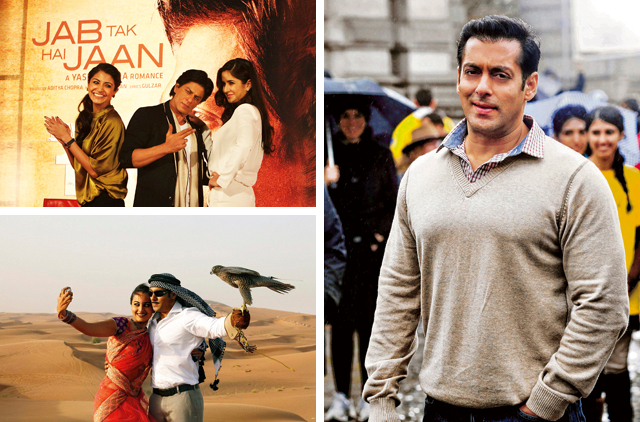
It’s one of the few clubs where you cannot apply for membership, be nominated or elected. Instead, you just make it. Bollywood star Aamir Khan kicked it off with his hugely popular Ghajini, and today its membership list has swelled to include some of the top names in movies including the other two Khans – Shahrukh and Salman – Akshay Kumar, Ajay Devgn, Hrithik Roshan, Abhishek Bachchan, Ranbir Kapoor, Deepika Padukone and Kareena Kapoor.
Wondering what it is? Welcome to Bollywood’s billion-rupee club, better known as the Rs100 crore club. Although not an actual organisation – it’s just a term used by the Indian film fraternity to separate the hugely financially successful stars from the rest – almost every actor vies to be listed as a member.
The entrance criterion is simple: you need to have starred in a film that has netted a billion rupees (Dh67,979,455) or more in India in 45 days or less. But there is one condition: the film must have earned that amount in net collections, not gross.
For those who came in late, gross collection is the total amount collected from cinemas across the country screening that film. Net collection is what the distributors have in hand after paying off the various government taxes. So what is this elite film club that seems to have become the new benchmark in Bollywood? Should a star have the billion-rupee credential to be considered a “bankable” lead? Is the billion-rupee film a product of Bollywood’s over-the-top PR machinery?
Shashilal Nair, who’s been making movies since the mid-1980s, including the Shahrukh film One Two Ka Four, explains the machinations behind a blockbuster. “Today, around 5,000 prints of a Bollywood film are distributed across India. The ticket price at most multiplexes in India is around Rs200 (Dh14). Given the large number of prints, a film can rake in Rs1 billion over a Friday-Saturday-Sunday weekend if the movie runs to full houses.”
Many films become instant hits simply because of high-powered publicity campaigns that producers whip up prior to the release, says Shashilal, adding that the marketing budget of films alone is often around Rs100 million (Dh679,794) – an amount that a few years ago could be used to finance a reasonably good film.
“In simple terms, a big name star plus a huge publicity budget plus a good weekend (one that corresponds with a festival or a national holiday) equals a Rs1 billion movie,’’ says Shashilal. But surely if it was that easy every actor or actress would be doing it? It was Aamir Khan who gave rise to this club in 2008. His film Ghajini became the first Bollywood film to cross the psychological benchmark of Rs1 billion and the media created the club tag.
“When his next film 3 Idiots beat that record reaching the magical figure in just nine days, the Rs100 crore club got well and firmly entrenched in Bollywood,’’ says Shashilal. 3 Idiots went on to become the highest-grossing Bollywood film of all time – Rs3.85 billion and counting. It didn’t take long for the media, stars and viewers to begin speculating about every movie being churned out of Bollywood studios – would it gross Rs1 billion or become just an also-ran?
The other Khans were hot on Aamir’s heels. Salman made it in 2010 with Dabangg, which netted Rs1.43 billion. Shahrukh was the last Khan to make the club with Ra.One. Salman underscored his sellability when his two movies Ready and Bodyguard crossed the Rs1 billion mark with net collections of Rs1.22 billion and Rs1.45 billion respectively making the three Khans – Shahrukh, Salman and Aamir – the ruling trio in this exclusive club.
However, Salman has been quoted as saying that the 100-crore club is overhyped. “There are many great films, which are not a part of this club,” he has been reported as saying. “Of course, I would want my film to make a lot of money but I don’t believe that numbers justify how good a film is.’’
Another popular actor who also believes the 100-crore club is hugely hyped is Priyanka Chopra. “Why can’t we talk about films that have not had a Rs1 billion budget and have been hugely successful?” she asks. “Films, which in terms of ratio, have been more successful than a 1-billion film would have been Kahaani, Vicky Donor, The Dirty Picture. I don’t think you have a hit film only if you’re in the Rs100 crore club,” she has said.
Veteran actor and filmmaker Pankaj Kapur also attributes the club to media hype. The buzz around Rs100 crore club movies is the same as the olden days’ silver jubilees, he has said. “It is a mere tool for film publicity.’’ But there is no denying the fact that starring in a Rs1-billion film means you can immediately up your fees for your next film.
And eager to cash in on this trend, it triggered a race where all the leading Bollywood actors began to put in anything it takes – read massive publicity blitzes – hoping their movies make it to the exclusive club. While none of the stars will acknowledge the existence of this club directly, Akshay referred to it obliquely in an interview. “Of course, there is a slight stress, a little tension,” he once said about his films grossing Rs1 billion.
“If a film does well, it’s great. But if it doesn’t then you try again.” Does all this mean that Bollywood films have suddenly become crowd pullers? Not really, say Bollywood analysts. The Rs100 crore club is just the film industry adjusting to the times, they say. “This – huge publicity budgets coupled with large number of prints – used to happen in Hollywood decades back,” says Shashilal.
“Earlier, the cost of making a film print was high so producers restricted the number of prints to around 300 at the most. Today, however, with cinemas having gone digital, it doesn’t cost much to make thousands of prints and distribute it across India at the same time,’’ he says. And more prints can lead to more earnings.
Siddique, who directed the Rs1 billion netter Bodyguard, says his job was only to ‘make a good film’. “I didn’t know anything about the publicity campaign,” he says. “The producer Atul Agnihotri (Salman’s brother-in-law) was the one who orchestrated the entire campaign and it’s [partly] due to the publicity that Bodyguard grossed Rs1 billion in a week.”
However, not everybody is happy with this new trend of chasing the magical figure at any cost. The most important factor to guarantee a film making it to the club is a big star, says an industry insider. The result is that budding talent goes begging, he says. “If you can get a big star to act in film you can do just about anything and romp home,” says a veteran producer, who prefers anonymity. He’s been trying to put together a low-budget project with lesser-known stars without success for the past few years.
All the more reason for filmmakers as well as stars to try to gatecrash the club. “It’s definitely very important because the game has entirely changed now,” says the producer. “No longer do films celebrate jubilees or 100-day runs at the theatres... it’s all a matter of weekend collections. The major share of revenue comes from the weekend collection, and with ticket prices soaring and collections creating records at the box office you are judged, or your popularity is at stake, if the film does not reach the Rs1 billion mark.”
According to the producer, actors like Salman, Shahrukh, Aamir, Ajay and Akshay vie to have their films reach this mark because only then will distributors and corporate producers back their next films. “The net collections affect their prices too, what with actors these days staking a claim in the shares,” he says. “Besides, most of the top-rung actors are producers or are turning producers, eager to grab a slice of the pie.”
The benefits trickle down the ranks This race to star in a potential Rs1 billion film is benefitting the lower rung stars as well “simply because the Rs100 crore club members can only do so many films a year,’’ says a producer. “So if a producer cannot get a Khan or Akshay or someone from the club they’ll sign up smaller stars like Ranbir Kapoor or Imran Khan or Imran Hashmi. They also bankroll new talents, smaller names, so everybody has work.”
Apart from collections at the box office, producers and distributors also earn huge sums from TV and video rights. Some even get massive subsidies for shooting overseas. The subsidy angles work like this, says a producer: “If I shoot in London for 50 days, and if I show the UK tourism department I spent £30,000 (Dh172,000), then I get paid back a hefty percentage of it!”
So a reason why Bollywood filmmakers shoot abroad is not just to use exotic backdrops in their films, but because of the subsidies filmmakers get from foreign governments to shoot their films in those locations, which in turn lead to tourist inflow in those countries. There are unconfirmed reports that Fiji has declared a 50 per cent subsidy to filmmakers who shoot their films there, while the UK returns 25 to 30 per cent of the money spent by filmmakers.
Don 2 reportedly received between Rs120 million and Rs150 million from the German government as subsidies. Britain paid the Ra.One team Rs200 million, and around Rs20 million to the makers of Desi Boyz, according to reports in a section of the Indian media. To top it all, shooting abroad works out cheaper for the producer as they take only a skeleton crew along with the cast. Usually the entire film is completed in a single schedule, thus reducing costs.
After the success of the Hrithik Roshan film Zindagi Na Milegi Dobara, there was reportedly an increase of 32 per cent in the number of Indian tourists to Spain where the film was shot. Indians tourists are said to have flocked to Prague after seeing Ranbir Kapoor’s Rockstar because the locales looked so picturesque.
Little wonder then that the list of Rs1 billion grossers has been increasing every year. In 2012 nine films crashed the barrier – Agneepath, Housefull 2, Rowdy Rathore, Bol Bachchan, Ek Tha Tiger, Barfi!, Son of Sardaar, Jab Tak Hai Jaan and Dabangg 2. Salman Khan broke his own record when his Ek Tha Tiger grossed Rs1 billion in just five days. With the membership increasing by the day, the Rs100 crore club is here to stay.














